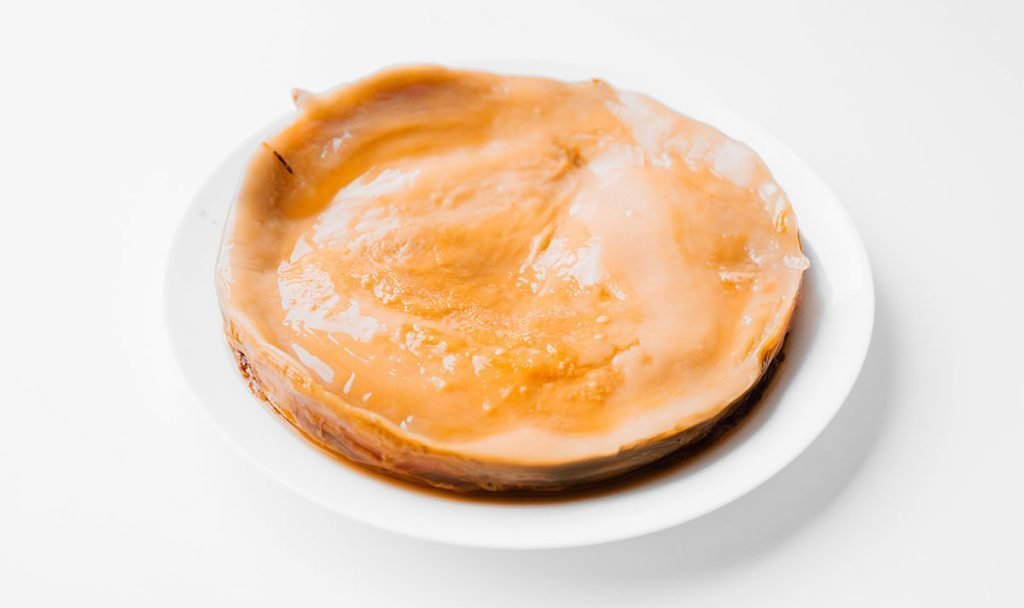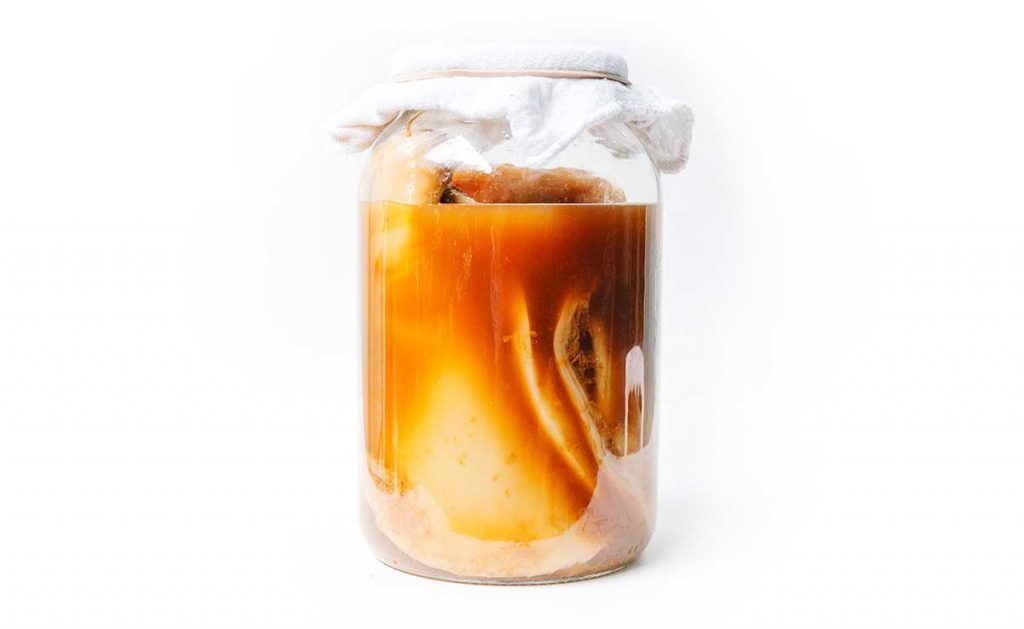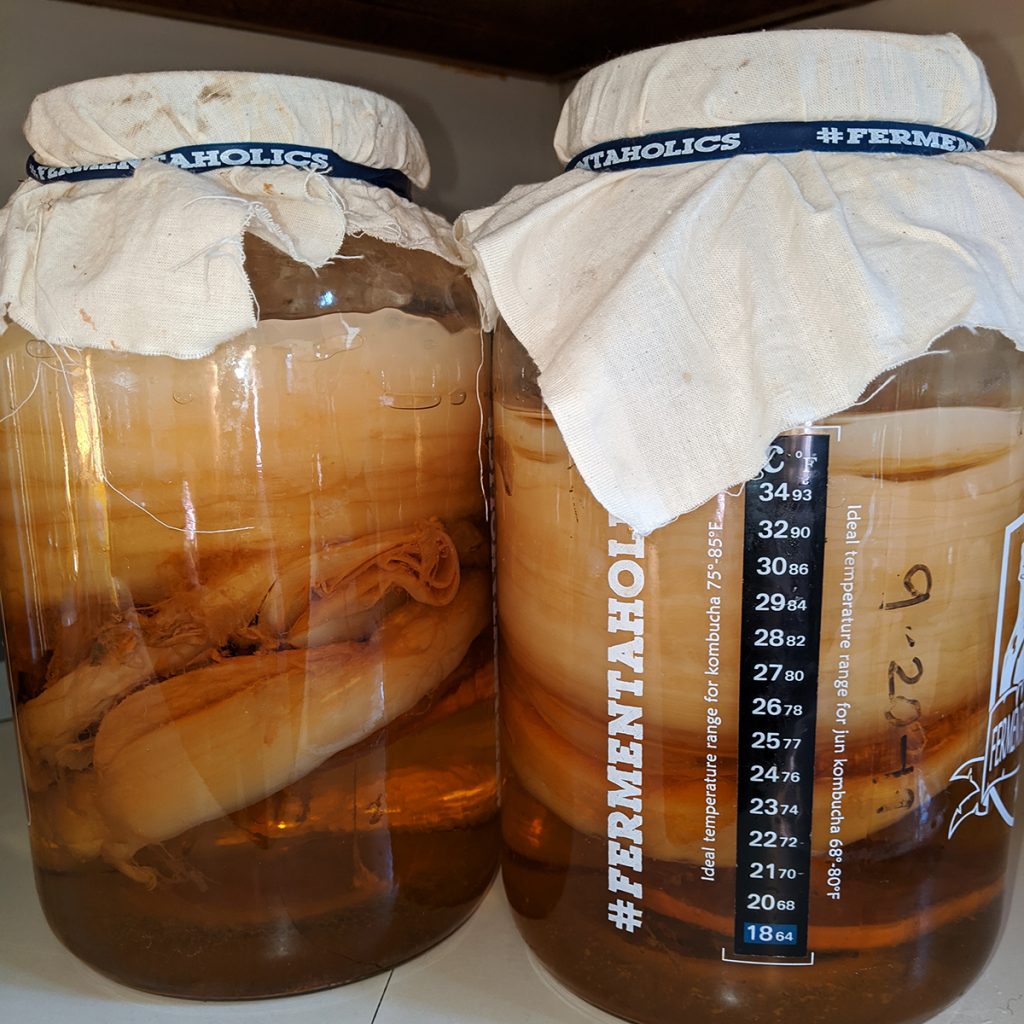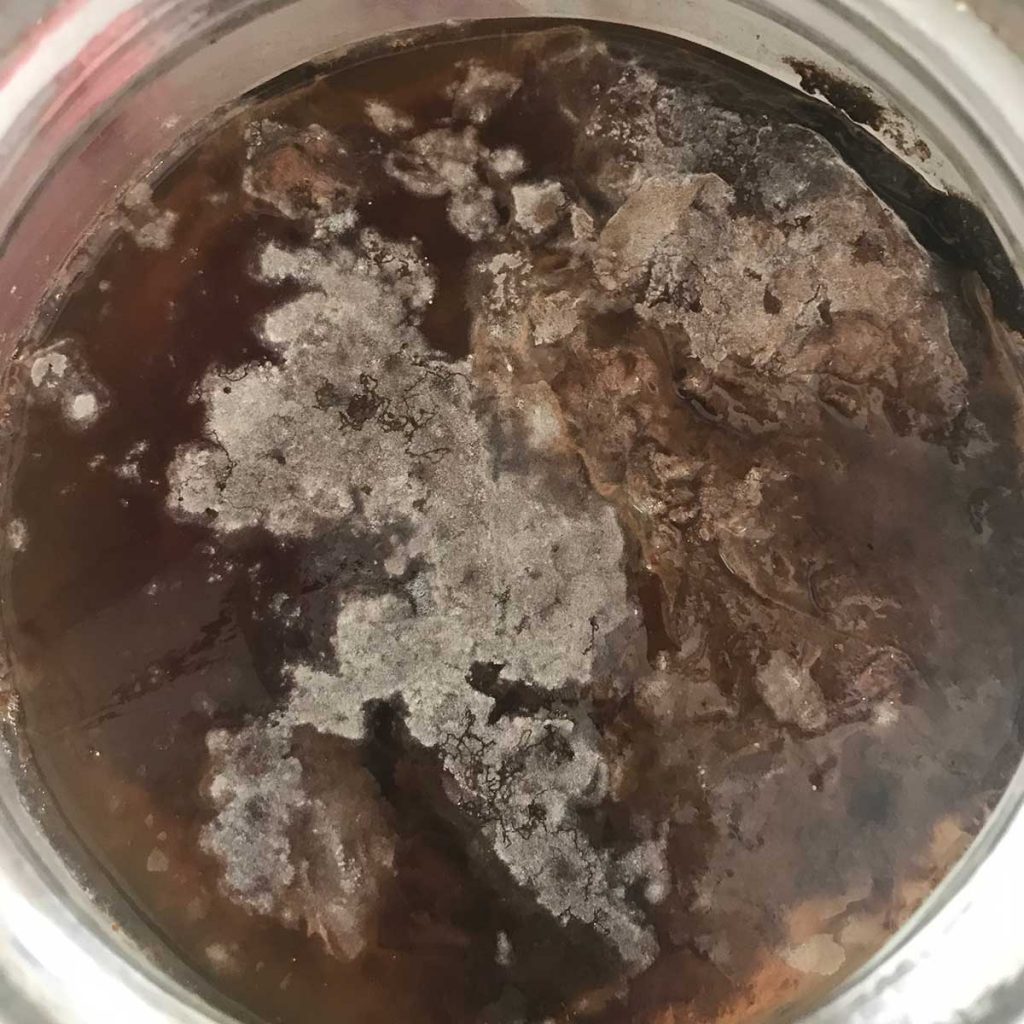If you’ve been brewing kombucha for a while, you may have started to wonder…how long does a SCOBY last? We’re breaking down the basics of the kombucha SCOBY lifespan here!

What is a SCOBY?
Before we dive into the lifespan of a kombucha SCOBY, it’s important to understand what a SCOBY actually is.
SCOBY is an acronym that stands for Symbiotic Culture Of Bacteria and Yeast. While the pellicle on top of the kombucha has come to be known as a SCOBY, technically the starter tea is the SCOBY, and the pellicle is simply the pellicle (but because 90% of people think that the pellicle is the SCOBY, that’s just what we call it to prevent even more confusion!)
So what makes the SCOBY/pellicle look and feel the way that it does? Well it consists mostly of cellulose, which is a natural bi-product of kombucha fermentation. If you remember back to biology class, cellulose is the same stuff that makes plant cell walls and veggie fibers!

Are kombucha SCOBYs reusable?
So now that we know what the SCOBY/pellicle is made of, can you reuse it from batch to batch?
Abso-freakin’-lutely! You can (and should) reuse the SCOBY/pellicle from one batch to the next. The built up cellulose helps to create a slightly anaerobic environment for the bacteria to thrive in, and it also contains bacteria and yeast needed to jumpstart fermentation (plus, you spent all that time making the SCOBY, why throw it away?!)

How long does a SCOBY last?
Put simply, kombucha SCOBYs can be reused for many years.
Realistically, however, you simply won’t need it to last that long. Your SCOBY grows and divides with each batch of kombucha, so you will constantly be growing new SCOBYs. Simply remove the older layers and transfer the new layers to your next batch.

When to replace your SCOBY
You should replace your kombucha SCOBY if you ever find traces of mold on it, or if it begins to turn black. But when treated with love and kept in the right environment, your SCOBY should last for years to come!
Need more SCOBY tips? Here’s how to care for your SCOBY when taking a break from brewing, and some fun ideas for using leftover SCOBYs!


When I use new scoby ,remove top layer? Do I keep old layer or disguard?
Yes remove the top layer! The bottom layer has a lot of yeast on it that will be beneficial to the brew 🙂
scoby was put in refridgerator fr a could weeks then removed that counter. it’s been there for several weeks. is it useable?
As long as there isn’t signs of mold I think it should be okay!
After a few months break from kombucha my friend and I have started again with some donated scobi which we have split and shared. We have both stated to use it and both become ill with bad stomach and digestive problems. What has gone written and can they be rescued? I had to stay in bed and cancel a meal out and trip to the cinema I feel so poorly. Any advice?
Hi Christine! I’m so sorry to hear it. If you both became ill it’s very likely that there was contamination or mold in your kombucha. I would highly recommend throwing it all away and cleaning your supplies very well before starting again.
I’ve left my scoby in the fridge for three months without feeding it while I was traveling. It looks ok, and it smells ok. How can I tell if it’s still alive?
It’s very likely still alive! Only way to know is to start brewing with it 😀
I used to make Kombucha a lot but stopped when my husband and I started KETO. I was told, because of the sugar, that it wasn’t KETO friendly. Since then I have come to realize and hope I am right that the sugar is eaten up and there fore isn’t a KETO issue. I found two Scoby’s that I purchased from Brindle Southern Farms in 2017. They are still sealed in the packets they came in and have been in a jar with a bale fastener. There is no mold in the packets so, do you think they are still safe? Also, I have issues with caffeine and I cannot remember if I can make the Kombucha with decaffeinated tea. Thank you for your help!!
I’d probably get new SCOBYs just to be safe, those are pretty old if they haven’t been fed or had air! And here’s how to make kombucha with less caffeine.
My scoby has been sitting in a jar on top of the fridge for about 2 years and I haven’t touched it. It is still producing new scobys and there is no sign of any mould or other issues. I’m thinking it’s still gonna be good to use? ????
Should be good to use as long as no mold!
If i have left the scoby in the jar for over a year and it hasn’t been given new tea, is it still good? It’s been sitting in a pantry, mostly dark and room temp environment.
As long as there isn’t mold, it could be okay still!
During this winter my Scoby (which has been actively making K for the last three years) is only producing a very thin daughter at every batch. My 2nd F is also very flat so I assumed this all is because temperature is too low. I got a heating pad (75F) but it doesn’t seem to do the trick on the 1st F: still a very thin daughter while the mother (Which is very thick and I reuse since the offspring layers are always so inconsistent) sinks to the bottom.
Any clue why it wouldn’t kick back,into high gear after the pad?
Much appreciated
Try adding a bottle of store bought (or unflavored kombucha that you’ve made) to introduce some potent new bacteria and yeast!
if it does have mold on it, should I throw the whole Scoby out or only the layers with the mold?
The whole thing, unfortunately!
Can you keep your scobies in the refrigerator? If so for how long? They are in a jar with kombucha
I wouldn’t advise keeping them in the fridge. Here’s how to store them longterm! 😀
I received a scoby probably close to 2 yrs ago as a gift & put aside & unfortunately forgot all about it. Is it still safe to use?
It may be too old if it hasn’t been fed since then, but give it a shot! Just be very cautious of mold.
I received a scoby from you back in the spring. Is it still good to use, I was going to make some but thought I would ask. I just found it ????
Yep it should be good to use! As long as there are no signs of mold 😀
So I’m only making batches for myself. I have two jars going at a time. How many scoby’s should I keep in each? Should I replace the older ones? Sadly, I don’t have anyone to share with.
Thanks!
Just 1 in each jar! You don’t want too many as they take up room where precious kombucha could be. Just remove the oldest layers as they grow!
Please explain the image of the SCOBY/pellicle that is filling the entire jar! What is the purpose of letting it get that thick?
Oh I see… it is a Scoby Hotel!
This is just a way of storing it in case you need backups (or want to give to friends, sell etc).
I have not fed my Scoby hotel for months. Is it still OK to use it??
Thanks,
Jim
Yep, as long as there isn’t any mold it should be fine 😀